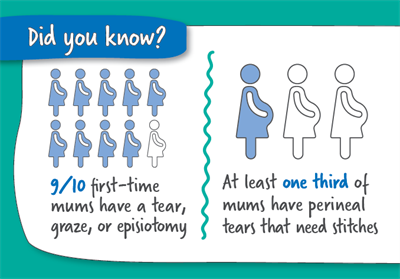The following are signs that your pelvic floor needs attention:
- Urinary leaking with activities such as coughing, laughing, sneezing, lifting and jumping
- A sudden need to rush to the toilet for a wee or leaking urine on the way to the toilet
- A need to go to the toilet for a wee more frequently during the day or night
- Leakage of poo or difficulty controlling wind
- A sudden need to rush to the toilet for a poo or difficulty cleaning after a poo
- A feeling of heaviness, dragging or something ‘coming down’ inside your vagina
- A reduced or lack of sensation during intercourse
- Discomfort during sexual intercourse
Information on tears and assisted births
Your perineum is the area between your vaginal opening and back passage (anus). It is common for the perineum to tear to some extent during childbirth. Tears can also occur inside the vagina or other parts of the vulva, including the labia.

Ninety per cent of women giving birth vaginally will get a perineal tear (this number includes all types of tear). This most often occurs to the tissue and skin at the vaginal opening and sometimes affects the pelvic floor muscle as well. Sometimes an episiotomy may be required to assist during the delivery of your baby, and when instruments such as ventouse (suction cap) or forceps are used. A few women have a tear to the muscles of the back passage as well, and this is called a third or fourth degree tear.
Perineal massage
From 35 weeks onwards, you may choose to try perineal massage until your baby is born, which has been shown to reduce the risk of tears. This is particularly beneficial for first-time mothers. You may wish to ask your partner to help with this.
How to do it:
- Sit in a warm bath before you start. This may help loosen the muscles around your perineum.
- Find a comfy position. The best place is in bed. Prop yourself up with pillows to support your
back and bend your knees.
- Use a lubricant like vitamin E oil, almond oil or olive oil.
- Hold your thumbs in the position shown for about 1 minute (see diagram below). Press down
 towards the anus and to the sides of the vagina walls. Hold your thumbs in this position for about 1 minute. You will begin to feel a stretching sensation. Breathe deeply.
towards the anus and to the sides of the vagina walls. Hold your thumbs in this position for about 1 minute. You will begin to feel a stretching sensation. Breathe deeply.
- Gently massage the lower half of your vagina using a U shaped movement for 2-3 minutes. Repeat this 2-3 times.
- Repeat daily or when possible. It may take a couple of weeks of daily massage before you notice more elasticity in your perineal area.
For more information on other ways to reduce the risk of tearing in childbirth please ask your midwife.
After the birth of your baby a healthcare professional will offer you an examination to see if you have a tear. They will advise you if you need stitches. Most tears heal within 6 weeks with no long-term problems.
For women who do have problems after a tear (such as pain, difficulty going to the toilet, incontinence or
mental health problems) specialist help is available.
The following resources provide more information. Simply click on the links below: